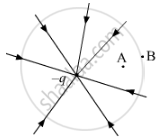Advertisements
Advertisements
Question
A hemisphere is uniformly charged positively. The electric field at a point on a diameter away from the centre is directed ______.
Options
perpendicular to the diameter
parallel to the diameter
at an angle tilted towards the diameter
at an angle tilted away from the diameter
Solution
A hemisphere is uniformly charged positively. The electric field at a point on a diameter away from the centre is directed perpendicular to the diameter.
Explanation:
In case of a uniformly positive charged hemisphere, if a point is situated at a point on a diameter away from the centre, the electric field should be perpendicular to the diameter. In this case, the component of electric field intensity parallels the diameter cancel out.
APPEARS IN
RELATED QUESTIONS
The field lines of a negative point charge are as shown in the figure. Does the kinetic energy of a small negative charge increase or decrease in going from B to A?

What is the function of uniform radial field and how is it produced?
Why must electrostatic field at the surface of a charged conductor be normal to the surface at every point? Give reason?
An electron falls from rest through a vertical distance h in a uniform and vertically upward directed electric field E. The direction of electric field is now reversed, keeping its magnitude the same. A proton is allowed to fall from rest in it through the same vertical distance h. The time of fall of the electron, in comparison to the time of fall of the proton is ______.
Assertion: On moving a distance two times the initial distance away from an infinitely long straight uniformly charged wire the electric field reduces to one-third of the initial value.
Reason: The electric field is inversely proportional to the distance from an infinitely long straight uniformly charged wire.
A particle of charge q and mass m moves rectilinearly under the action of electric field E = A – Bx, where A and B are positive constants and x is distance from the point where particle was initially at rest then the distance traveled by the particle before coming to rest and acceleration of particle at that moment are respectively.
Let there be a spherically symmetric charge distribution with charge density varying as `rho("r") = rho_0(5/4 - "r"/"R")` upto r = R, and `rho("r") = 0` for r > R, where r is the distance from the origin. The electric field at a distance r(r < R) from the origin is given by _________.
Consider two identical point charges located at points (0, 0) and (a, 0).
Is there a point on the line joining them at which the electric field is zero?
Consider two identical point charges located at points (0, 0) and (a, 0).
Is there a point on the line joining them at which the electric potential is zero?
An isolated point charge particle produces an electric field `vecE` at a point 3 m away from it. The distance of the point at which the field is `vecE/4` will be ______.
